Entrepreneurship Report: Ventures, Economy, and Growth Analysis
VerifiedAdded on 2021/06/22
|28
|7679
|106
Report
AI Summary
This report provides a comprehensive overview of entrepreneurship, focusing on various types of entrepreneurial ventures, including small businesses, scalable startups, large-scale enterprises, and social enterprises. It explores the definition of entrepreneurship, the characteristics of entrepreneurs, and the skills required to succeed in business. The report examines the similarities and differences between these ventures, highlighting their objectives, structures, and impact on the economy. Furthermore, it analyzes the impact of micro and small businesses on economic growth, particularly within the context of Vietnam, and discusses how these businesses contribute to different levels of the economy, from global to local. The report provides valuable insights into the scope, development, and growth of entrepreneurial ventures, offering a detailed understanding of entrepreneurship and its significance in the modern business landscape.

TABLE OF CONTENTS
INTRODUCTION..................................................................................................................................................................... 3
PART 1........................................................................................................................................................................................ 4
ENTREPRENEURSHIP OVERVIEW........................................................................................................................... 4
WHO ARE ENTREPRENEURS?............................................................................................................................... 4
DEFINITION OF ENTREPRENEURSHIP............................................................................................................. 5
DIFFERENT TYPES OF ENTREPRENEURIAL VENTURES AND RELATION TO THE TYPOLOGY
OF ENTREPRENEURSHIP.............................................................................................................................................. 6
SMALL BUSINESS ENTREPRENEURSHIP.......................................................................................................... 6
SCALABLE STARTUP ENTREPRENEURSHIP................................................................................................... 6
LARGE SCALE ENTREPRENEURSHIP.................................................................................................................. 7
SOCIAL ENTREPRENEURSHIP................................................................................................................................ 7
THE SIMILARITIES AND DIFFERENCES BETWEEN ENTREPRENEURIAL VENTURES....................8
Similarities between entrepreneurial ventures........................................................................................... 8
Differences between entrepreneurial ventures............................................................................................ 8
INVESTIGATING DIVERSE RANGE OF ENTREPRENEURIAL VENTURES TO DEMONSTRATE AN
UNDERSTANDING OF ENTREPRENEURSHIP IN BOTH PUBLIC AND CORPORATE SECTOR......9
In public sector.............................................................................................................................................................. 9
In corporate sector...................................................................................................................................................... 9
THE SCOPE, DEVELOPMENT AND GROWTH OF ENTREPRENEURIAL VENTURES.......................11
The scope of entrepreneurial ventures.......................................................................................................... 11
Development and growth of entrepreneurial ventures.........................................................................12
PART 2..................................................................................................................................................................................... 12
HOW MICRO AND SMALL BUSINESSES IMPACT ON THE ECONOMY...................................................12
THE IMPORTANCE OF SMALL BUSINESSES AND BUSINESS START-UPS TO THE GROWTH OF
THE SOCIAL ECONOMY............................................................................................................................................... 14
Contribution of SMEs and small business toward Vietnam’s Economy..........................................14
THE DIFFERENCES MAKE BY SMALL, MEDIUM AND LARGE BUSINESSES TO THE VIETNAM’S
ECONOMY.......................................................................................................................................................................... 20
HOW SMALL BUSINESSES HAVE AN IMPACT ON DIFFERENT LEVELS OF THE ECONOMY IN A
GLOBAL, REGIONAL, NATIONAL AND INTERNATIONAL CONTEXT.....................................................22
1
INTRODUCTION..................................................................................................................................................................... 3
PART 1........................................................................................................................................................................................ 4
ENTREPRENEURSHIP OVERVIEW........................................................................................................................... 4
WHO ARE ENTREPRENEURS?............................................................................................................................... 4
DEFINITION OF ENTREPRENEURSHIP............................................................................................................. 5
DIFFERENT TYPES OF ENTREPRENEURIAL VENTURES AND RELATION TO THE TYPOLOGY
OF ENTREPRENEURSHIP.............................................................................................................................................. 6
SMALL BUSINESS ENTREPRENEURSHIP.......................................................................................................... 6
SCALABLE STARTUP ENTREPRENEURSHIP................................................................................................... 6
LARGE SCALE ENTREPRENEURSHIP.................................................................................................................. 7
SOCIAL ENTREPRENEURSHIP................................................................................................................................ 7
THE SIMILARITIES AND DIFFERENCES BETWEEN ENTREPRENEURIAL VENTURES....................8
Similarities between entrepreneurial ventures........................................................................................... 8
Differences between entrepreneurial ventures............................................................................................ 8
INVESTIGATING DIVERSE RANGE OF ENTREPRENEURIAL VENTURES TO DEMONSTRATE AN
UNDERSTANDING OF ENTREPRENEURSHIP IN BOTH PUBLIC AND CORPORATE SECTOR......9
In public sector.............................................................................................................................................................. 9
In corporate sector...................................................................................................................................................... 9
THE SCOPE, DEVELOPMENT AND GROWTH OF ENTREPRENEURIAL VENTURES.......................11
The scope of entrepreneurial ventures.......................................................................................................... 11
Development and growth of entrepreneurial ventures.........................................................................12
PART 2..................................................................................................................................................................................... 12
HOW MICRO AND SMALL BUSINESSES IMPACT ON THE ECONOMY...................................................12
THE IMPORTANCE OF SMALL BUSINESSES AND BUSINESS START-UPS TO THE GROWTH OF
THE SOCIAL ECONOMY............................................................................................................................................... 14
Contribution of SMEs and small business toward Vietnam’s Economy..........................................14
THE DIFFERENCES MAKE BY SMALL, MEDIUM AND LARGE BUSINESSES TO THE VIETNAM’S
ECONOMY.......................................................................................................................................................................... 20
HOW SMALL BUSINESSES HAVE AN IMPACT ON DIFFERENT LEVELS OF THE ECONOMY IN A
GLOBAL, REGIONAL, NATIONAL AND INTERNATIONAL CONTEXT.....................................................22
1
Paraphrase This Document
Need a fresh take? Get an instant paraphrase of this document with our AI Paraphraser

CONCLUSION......................................................................................................................................................................... 23
REFERENCE........................................................................................................................................................................... 24
2
REFERENCE........................................................................................................................................................................... 24
2
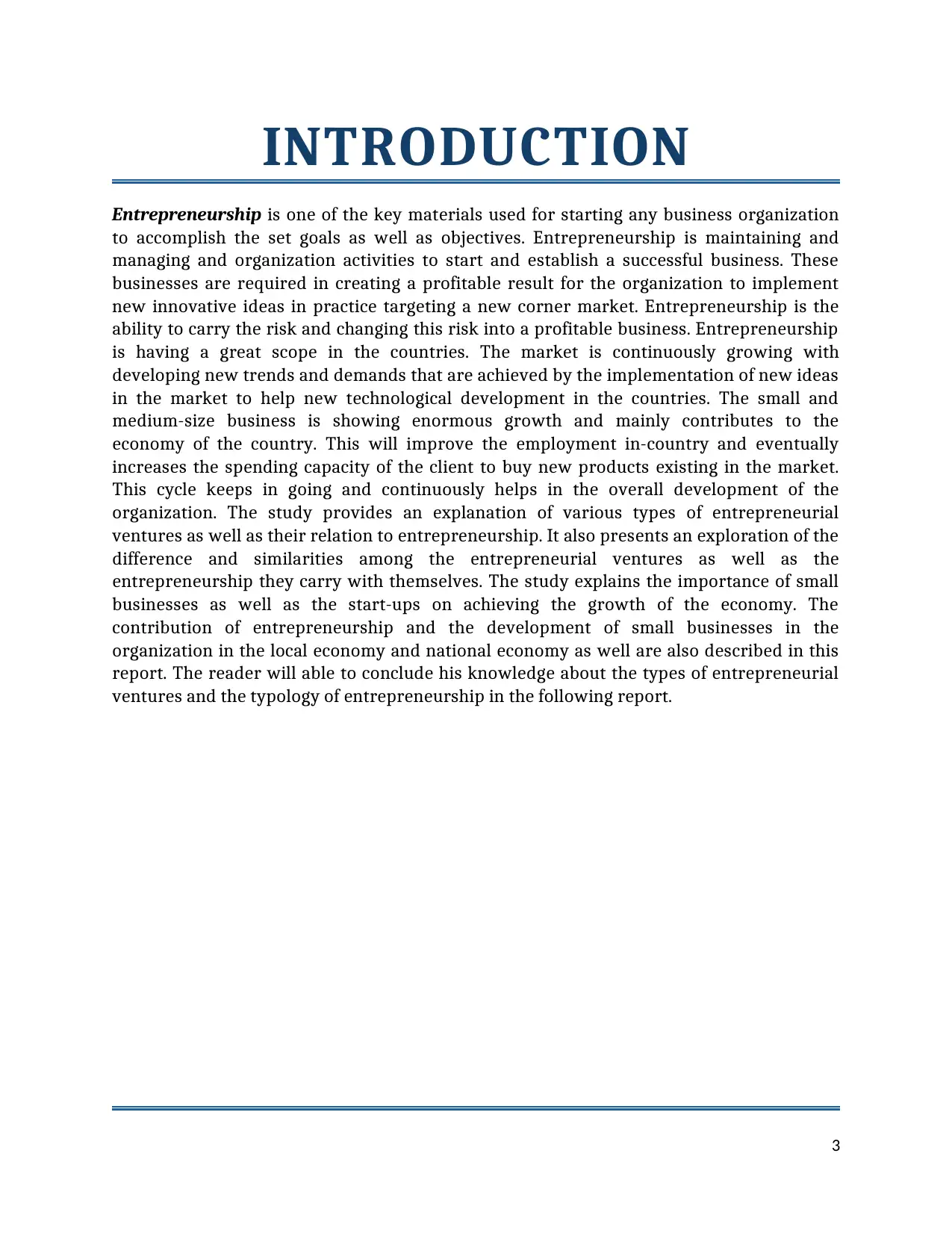
INTRODUCTION
Entrepreneurship is one of the key materials used for starting any business organization
to accomplish the set goals as well as objectives. Entrepreneurship is maintaining and
managing and organization activities to start and establish a successful business. These
businesses are required in creating a profitable result for the organization to implement
new innovative ideas in practice targeting a new corner market. Entrepreneurship is the
ability to carry the risk and changing this risk into a profitable business. Entrepreneurship
is having a great scope in the countries. The market is continuously growing with
developing new trends and demands that are achieved by the implementation of new ideas
in the market to help new technological development in the countries. The small and
medium-size business is showing enormous growth and mainly contributes to the
economy of the country. This will improve the employment in-country and eventually
increases the spending capacity of the client to buy new products existing in the market.
This cycle keeps in going and continuously helps in the overall development of the
organization. The study provides an explanation of various types of entrepreneurial
ventures as well as their relation to entrepreneurship. It also presents an exploration of the
difference and similarities among the entrepreneurial ventures as well as the
entrepreneurship they carry with themselves. The study explains the importance of small
businesses as well as the start-ups on achieving the growth of the economy. The
contribution of entrepreneurship and the development of small businesses in the
organization in the local economy and national economy as well are also described in this
report. The reader will able to conclude his knowledge about the types of entrepreneurial
ventures and the typology of entrepreneurship in the following report.
3
Entrepreneurship is one of the key materials used for starting any business organization
to accomplish the set goals as well as objectives. Entrepreneurship is maintaining and
managing and organization activities to start and establish a successful business. These
businesses are required in creating a profitable result for the organization to implement
new innovative ideas in practice targeting a new corner market. Entrepreneurship is the
ability to carry the risk and changing this risk into a profitable business. Entrepreneurship
is having a great scope in the countries. The market is continuously growing with
developing new trends and demands that are achieved by the implementation of new ideas
in the market to help new technological development in the countries. The small and
medium-size business is showing enormous growth and mainly contributes to the
economy of the country. This will improve the employment in-country and eventually
increases the spending capacity of the client to buy new products existing in the market.
This cycle keeps in going and continuously helps in the overall development of the
organization. The study provides an explanation of various types of entrepreneurial
ventures as well as their relation to entrepreneurship. It also presents an exploration of the
difference and similarities among the entrepreneurial ventures as well as the
entrepreneurship they carry with themselves. The study explains the importance of small
businesses as well as the start-ups on achieving the growth of the economy. The
contribution of entrepreneurship and the development of small businesses in the
organization in the local economy and national economy as well are also described in this
report. The reader will able to conclude his knowledge about the types of entrepreneurial
ventures and the typology of entrepreneurship in the following report.
3
⊘ This is a preview!⊘
Do you want full access?
Subscribe today to unlock all pages.

Trusted by 1+ million students worldwide

PART 1
ENTREPRENEURSHIP OVERVIEW
Entrepreneurship is the way to set up a business by analyzing different risks related to it
such as financial or managerial. The entrepreneurial ventures can have different ownership
structures and the entrepreneurs need to have certain skills and characteristics to the
development and management of a business. The experience and personal background can
have a diverse effect on the entrepreneurship that can foster or hinder a business. The
report is going to focus on different types of entrepreneurial ventures, their effect on the
economy. Additionally, the skills and mindset needed to set up a business will be
elaborated along with the ways experience and personal background can affect a start-up
business (Rushworth, 2000).
WHO ARE ENTREPRENEURS?
People who start and/or operate a business
Individuals who discover market needs and launch new firms to meet those needs
Risk takers who provide an impetus for change, innovation, and progress
All active owner-managers (founders and/or managers of small businesses)
People who introduce a new product in an existing organization
The owner of an enterprise who by RISK and INITIATIVE attempts to make a profit
Vietnam’s entrepreneurs: highly educated, but inward looking
The survey shows entrepreneurs Vietnam tend to be older (aged 35 and over), mostly
male, highly educated, and with little international background. Sixty-four per cent of the
entrepreneurs surveyed were aged 35 and above, 63 per cent were male, 78 per cent had a
university or college degree, and 85 per cent had no professional or academic experience
outside of Vietnam.
4
ENTREPRENEURSHIP OVERVIEW
Entrepreneurship is the way to set up a business by analyzing different risks related to it
such as financial or managerial. The entrepreneurial ventures can have different ownership
structures and the entrepreneurs need to have certain skills and characteristics to the
development and management of a business. The experience and personal background can
have a diverse effect on the entrepreneurship that can foster or hinder a business. The
report is going to focus on different types of entrepreneurial ventures, their effect on the
economy. Additionally, the skills and mindset needed to set up a business will be
elaborated along with the ways experience and personal background can affect a start-up
business (Rushworth, 2000).
WHO ARE ENTREPRENEURS?
People who start and/or operate a business
Individuals who discover market needs and launch new firms to meet those needs
Risk takers who provide an impetus for change, innovation, and progress
All active owner-managers (founders and/or managers of small businesses)
People who introduce a new product in an existing organization
The owner of an enterprise who by RISK and INITIATIVE attempts to make a profit
Vietnam’s entrepreneurs: highly educated, but inward looking
The survey shows entrepreneurs Vietnam tend to be older (aged 35 and over), mostly
male, highly educated, and with little international background. Sixty-four per cent of the
entrepreneurs surveyed were aged 35 and above, 63 per cent were male, 78 per cent had a
university or college degree, and 85 per cent had no professional or academic experience
outside of Vietnam.
4
Paraphrase This Document
Need a fresh take? Get an instant paraphrase of this document with our AI Paraphraser
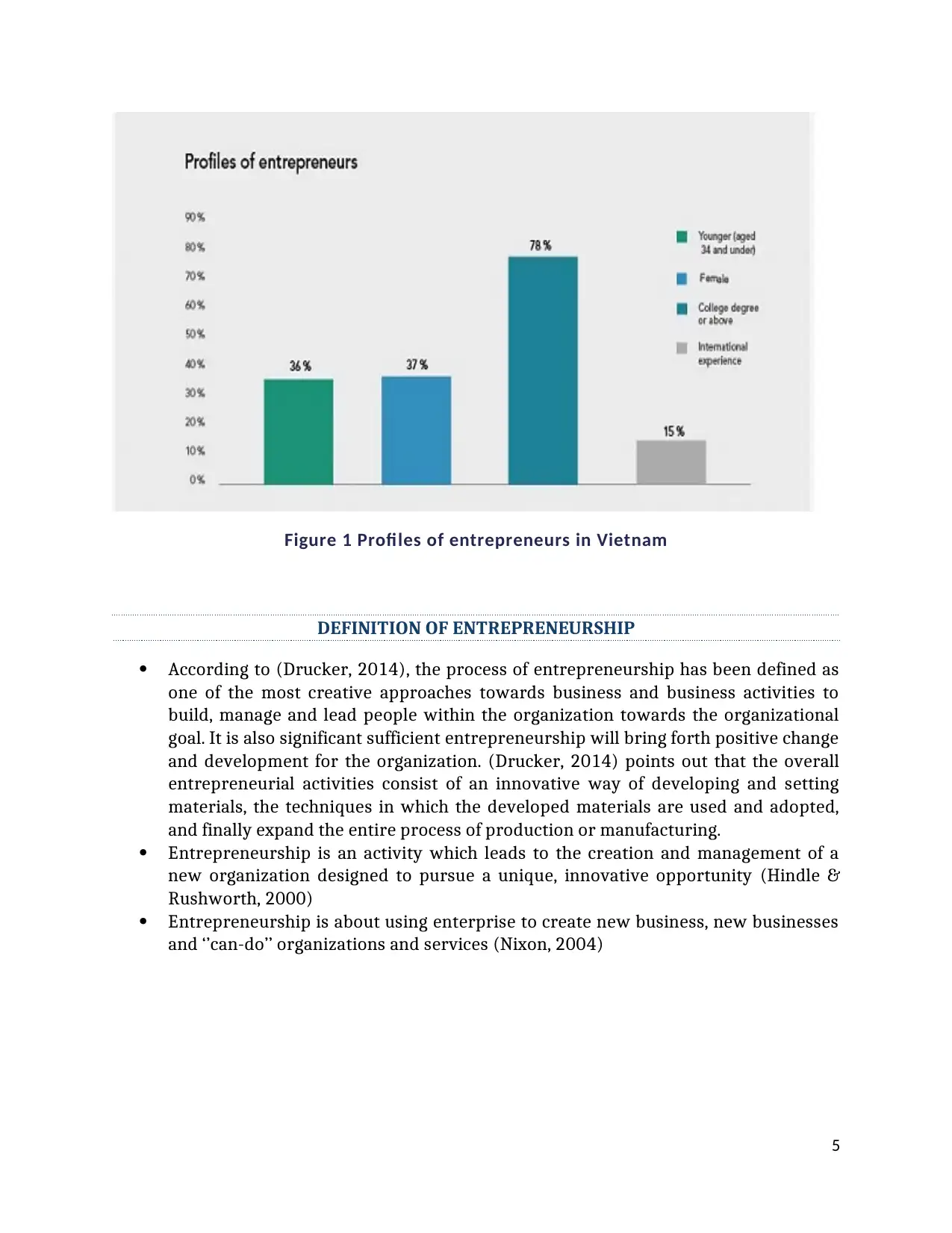
Figure 1 Profiles of entrepreneurs in Vietnam
DEFINITION OF ENTREPRENEURSHIP
According to (Drucker, 2014), the process of entrepreneurship has been defined as
one of the most creative approaches towards business and business activities to
build, manage and lead people within the organization towards the organizational
goal. It is also significant sufficient entrepreneurship will bring forth positive change
and development for the organization. (Drucker, 2014) points out that the overall
entrepreneurial activities consist of an innovative way of developing and setting
materials, the techniques in which the developed materials are used and adopted,
and finally expand the entire process of production or manufacturing.
Entrepreneurship is an activity which leads to the creation and management of a
new organization designed to pursue a unique, innovative opportunity (Hindle &
Rushworth, 2000)
Entrepreneurship is about using enterprise to create new business, new businesses
and ‘’can-do’’ organizations and services (Nixon, 2004)
5
DEFINITION OF ENTREPRENEURSHIP
According to (Drucker, 2014), the process of entrepreneurship has been defined as
one of the most creative approaches towards business and business activities to
build, manage and lead people within the organization towards the organizational
goal. It is also significant sufficient entrepreneurship will bring forth positive change
and development for the organization. (Drucker, 2014) points out that the overall
entrepreneurial activities consist of an innovative way of developing and setting
materials, the techniques in which the developed materials are used and adopted,
and finally expand the entire process of production or manufacturing.
Entrepreneurship is an activity which leads to the creation and management of a
new organization designed to pursue a unique, innovative opportunity (Hindle &
Rushworth, 2000)
Entrepreneurship is about using enterprise to create new business, new businesses
and ‘’can-do’’ organizations and services (Nixon, 2004)
5
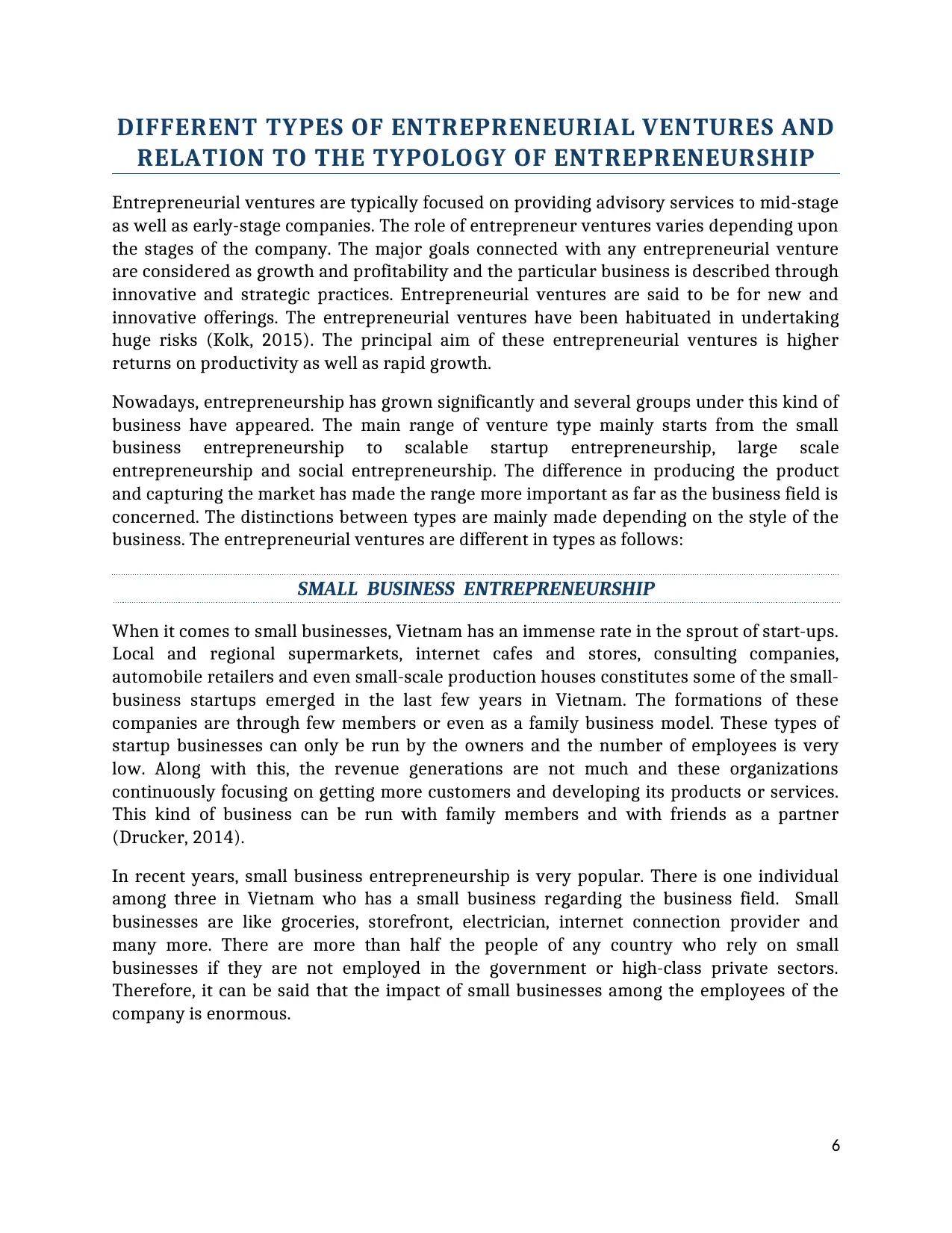
DIFFERENT TYPES OF ENTREPRENEURIAL VENTURES AND
RELATION TO THE TYPOLOGY OF ENTREPRENEURSHIP
Entrepreneurial ventures are typically focused on providing advisory services to mid-stage
as well as early-stage companies. The role of entrepreneur ventures varies depending upon
the stages of the company. The major goals connected with any entrepreneurial venture
are considered as growth and profitability and the particular business is described through
innovative and strategic practices. Entrepreneurial ventures are said to be for new and
innovative offerings. The entrepreneurial ventures have been habituated in undertaking
huge risks (Kolk, 2015). The principal aim of these entrepreneurial ventures is higher
returns on productivity as well as rapid growth.
Nowadays, entrepreneurship has grown significantly and several groups under this kind of
business have appeared. The main range of venture type mainly starts from the small
business entrepreneurship to scalable startup entrepreneurship, large scale
entrepreneurship and social entrepreneurship. The difference in producing the product
and capturing the market has made the range more important as far as the business field is
concerned. The distinctions between types are mainly made depending on the style of the
business. The entrepreneurial ventures are different in types as follows:
SMALL BUSINESS ENTREPRENEURSHIP
When it comes to small businesses, Vietnam has an immense rate in the sprout of start-ups.
Local and regional supermarkets, internet cafes and stores, consulting companies,
automobile retailers and even small-scale production houses constitutes some of the small-
business startups emerged in the last few years in Vietnam. The formations of these
companies are through few members or even as a family business model. These types of
startup businesses can only be run by the owners and the number of employees is very
low. Along with this, the revenue generations are not much and these organizations
continuously focusing on getting more customers and developing its products or services.
This kind of business can be run with family members and with friends as a partner
(Drucker, 2014).
In recent years, small business entrepreneurship is very popular. There is one individual
among three in Vietnam who has a small business regarding the business field. Small
businesses are like groceries, storefront, electrician, internet connection provider and
many more. There are more than half the people of any country who rely on small
businesses if they are not employed in the government or high-class private sectors.
Therefore, it can be said that the impact of small businesses among the employees of the
company is enormous.
6
RELATION TO THE TYPOLOGY OF ENTREPRENEURSHIP
Entrepreneurial ventures are typically focused on providing advisory services to mid-stage
as well as early-stage companies. The role of entrepreneur ventures varies depending upon
the stages of the company. The major goals connected with any entrepreneurial venture
are considered as growth and profitability and the particular business is described through
innovative and strategic practices. Entrepreneurial ventures are said to be for new and
innovative offerings. The entrepreneurial ventures have been habituated in undertaking
huge risks (Kolk, 2015). The principal aim of these entrepreneurial ventures is higher
returns on productivity as well as rapid growth.
Nowadays, entrepreneurship has grown significantly and several groups under this kind of
business have appeared. The main range of venture type mainly starts from the small
business entrepreneurship to scalable startup entrepreneurship, large scale
entrepreneurship and social entrepreneurship. The difference in producing the product
and capturing the market has made the range more important as far as the business field is
concerned. The distinctions between types are mainly made depending on the style of the
business. The entrepreneurial ventures are different in types as follows:
SMALL BUSINESS ENTREPRENEURSHIP
When it comes to small businesses, Vietnam has an immense rate in the sprout of start-ups.
Local and regional supermarkets, internet cafes and stores, consulting companies,
automobile retailers and even small-scale production houses constitutes some of the small-
business startups emerged in the last few years in Vietnam. The formations of these
companies are through few members or even as a family business model. These types of
startup businesses can only be run by the owners and the number of employees is very
low. Along with this, the revenue generations are not much and these organizations
continuously focusing on getting more customers and developing its products or services.
This kind of business can be run with family members and with friends as a partner
(Drucker, 2014).
In recent years, small business entrepreneurship is very popular. There is one individual
among three in Vietnam who has a small business regarding the business field. Small
businesses are like groceries, storefront, electrician, internet connection provider and
many more. There are more than half the people of any country who rely on small
businesses if they are not employed in the government or high-class private sectors.
Therefore, it can be said that the impact of small businesses among the employees of the
company is enormous.
6
⊘ This is a preview!⊘
Do you want full access?
Subscribe today to unlock all pages.

Trusted by 1+ million students worldwide
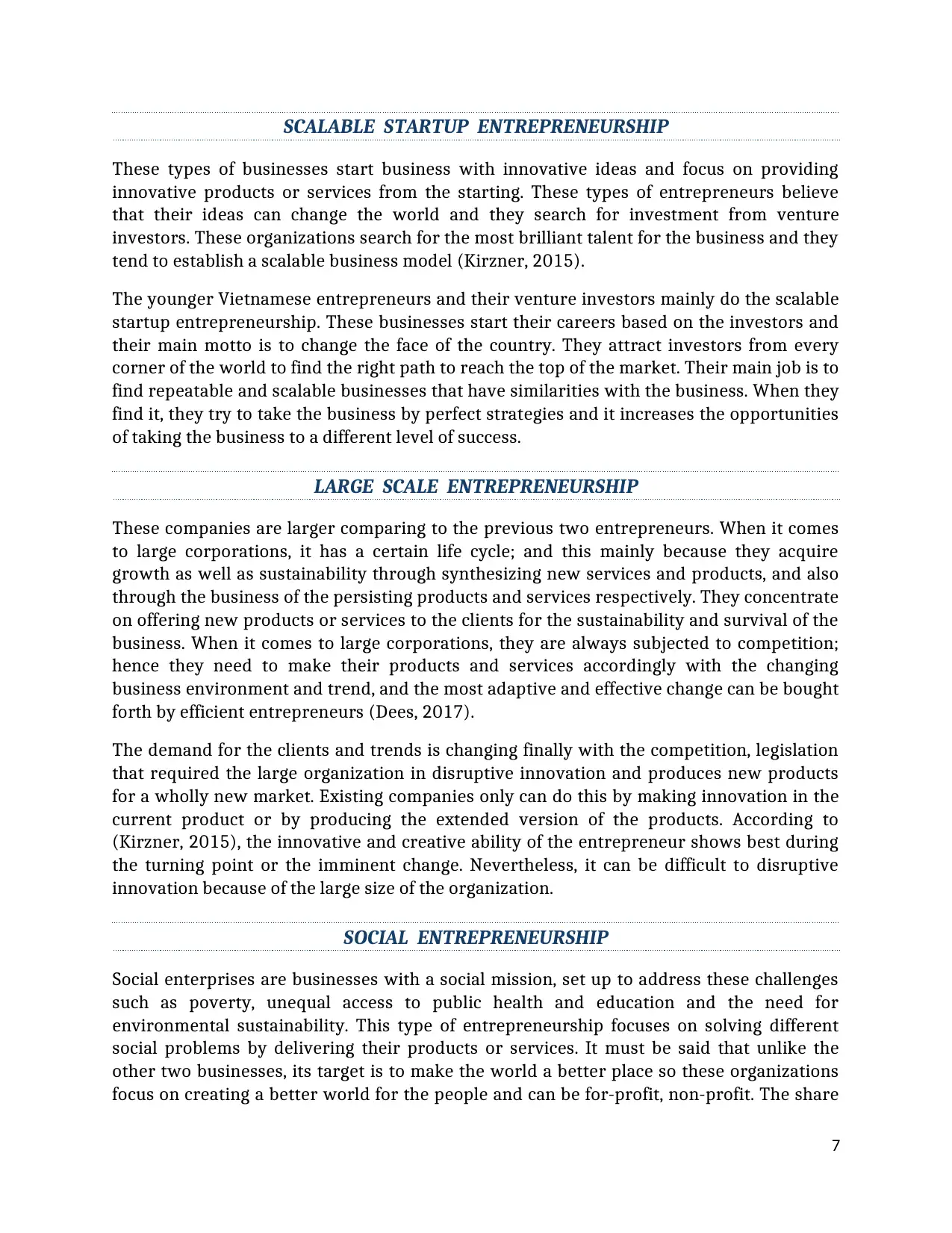
SCALABLE STARTUP ENTREPRENEURSHIP
These types of businesses start business with innovative ideas and focus on providing
innovative products or services from the starting. These types of entrepreneurs believe
that their ideas can change the world and they search for investment from venture
investors. These organizations search for the most brilliant talent for the business and they
tend to establish a scalable business model (Kirzner, 2015).
The younger Vietnamese entrepreneurs and their venture investors mainly do the scalable
startup entrepreneurship. These businesses start their careers based on the investors and
their main motto is to change the face of the country. They attract investors from every
corner of the world to find the right path to reach the top of the market. Their main job is to
find repeatable and scalable businesses that have similarities with the business. When they
find it, they try to take the business by perfect strategies and it increases the opportunities
of taking the business to a different level of success.
LARGE SCALE ENTREPRENEURSHIP
These companies are larger comparing to the previous two entrepreneurs. When it comes
to large corporations, it has a certain life cycle; and this mainly because they acquire
growth as well as sustainability through synthesizing new services and products, and also
through the business of the persisting products and services respectively. They concentrate
on offering new products or services to the clients for the sustainability and survival of the
business. When it comes to large corporations, they are always subjected to competition;
hence they need to make their products and services accordingly with the changing
business environment and trend, and the most adaptive and effective change can be bought
forth by efficient entrepreneurs (Dees, 2017).
The demand for the clients and trends is changing finally with the competition, legislation
that required the large organization in disruptive innovation and produces new products
for a wholly new market. Existing companies only can do this by making innovation in the
current product or by producing the extended version of the products. According to
(Kirzner, 2015), the innovative and creative ability of the entrepreneur shows best during
the turning point or the imminent change. Nevertheless, it can be difficult to disruptive
innovation because of the large size of the organization.
SOCIAL ENTREPRENEURSHIP
Social enterprises are businesses with a social mission, set up to address these challenges
such as poverty, unequal access to public health and education and the need for
environmental sustainability. This type of entrepreneurship focuses on solving different
social problems by delivering their products or services. It must be said that unlike the
other two businesses, its target is to make the world a better place so these organizations
focus on creating a better world for the people and can be for-profit, non-profit. The share
7
These types of businesses start business with innovative ideas and focus on providing
innovative products or services from the starting. These types of entrepreneurs believe
that their ideas can change the world and they search for investment from venture
investors. These organizations search for the most brilliant talent for the business and they
tend to establish a scalable business model (Kirzner, 2015).
The younger Vietnamese entrepreneurs and their venture investors mainly do the scalable
startup entrepreneurship. These businesses start their careers based on the investors and
their main motto is to change the face of the country. They attract investors from every
corner of the world to find the right path to reach the top of the market. Their main job is to
find repeatable and scalable businesses that have similarities with the business. When they
find it, they try to take the business by perfect strategies and it increases the opportunities
of taking the business to a different level of success.
LARGE SCALE ENTREPRENEURSHIP
These companies are larger comparing to the previous two entrepreneurs. When it comes
to large corporations, it has a certain life cycle; and this mainly because they acquire
growth as well as sustainability through synthesizing new services and products, and also
through the business of the persisting products and services respectively. They concentrate
on offering new products or services to the clients for the sustainability and survival of the
business. When it comes to large corporations, they are always subjected to competition;
hence they need to make their products and services accordingly with the changing
business environment and trend, and the most adaptive and effective change can be bought
forth by efficient entrepreneurs (Dees, 2017).
The demand for the clients and trends is changing finally with the competition, legislation
that required the large organization in disruptive innovation and produces new products
for a wholly new market. Existing companies only can do this by making innovation in the
current product or by producing the extended version of the products. According to
(Kirzner, 2015), the innovative and creative ability of the entrepreneur shows best during
the turning point or the imminent change. Nevertheless, it can be difficult to disruptive
innovation because of the large size of the organization.
SOCIAL ENTREPRENEURSHIP
Social enterprises are businesses with a social mission, set up to address these challenges
such as poverty, unequal access to public health and education and the need for
environmental sustainability. This type of entrepreneurship focuses on solving different
social problems by delivering their products or services. It must be said that unlike the
other two businesses, its target is to make the world a better place so these organizations
focus on creating a better world for the people and can be for-profit, non-profit. The share
7
Paraphrase This Document
Need a fresh take? Get an instant paraphrase of this document with our AI Paraphraser
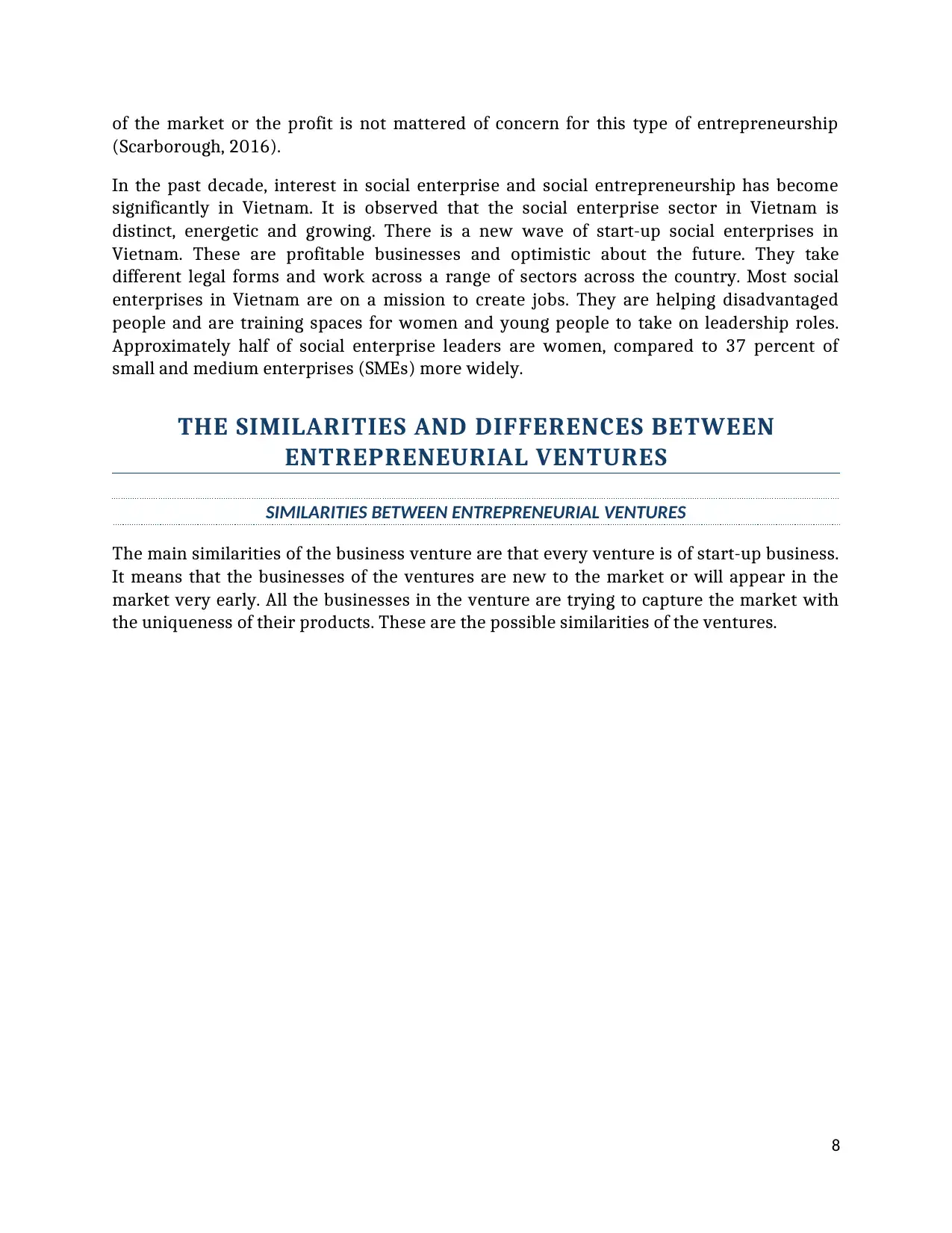
of the market or the profit is not mattered of concern for this type of entrepreneurship
(Scarborough, 2016).
In the past decade, interest in social enterprise and social entrepreneurship has become
significantly in Vietnam. It is observed that the social enterprise sector in Vietnam is
distinct, energetic and growing. There is a new wave of start-up social enterprises in
Vietnam. These are profitable businesses and optimistic about the future. They take
different legal forms and work across a range of sectors across the country. Most social
enterprises in Vietnam are on a mission to create jobs. They are helping disadvantaged
people and are training spaces for women and young people to take on leadership roles.
Approximately half of social enterprise leaders are women, compared to 37 percent of
small and medium enterprises (SMEs) more widely.
THE SIMILARITIES AND DIFFERENCES BETWEEN
ENTREPRENEURIAL VENTURES
SIMILARITIES BETWEEN ENTREPRENEURIAL VENTURES
The main similarities of the business venture are that every venture is of start-up business.
It means that the businesses of the ventures are new to the market or will appear in the
market very early. All the businesses in the venture are trying to capture the market with
the uniqueness of their products. These are the possible similarities of the ventures.
8
(Scarborough, 2016).
In the past decade, interest in social enterprise and social entrepreneurship has become
significantly in Vietnam. It is observed that the social enterprise sector in Vietnam is
distinct, energetic and growing. There is a new wave of start-up social enterprises in
Vietnam. These are profitable businesses and optimistic about the future. They take
different legal forms and work across a range of sectors across the country. Most social
enterprises in Vietnam are on a mission to create jobs. They are helping disadvantaged
people and are training spaces for women and young people to take on leadership roles.
Approximately half of social enterprise leaders are women, compared to 37 percent of
small and medium enterprises (SMEs) more widely.
THE SIMILARITIES AND DIFFERENCES BETWEEN
ENTREPRENEURIAL VENTURES
SIMILARITIES BETWEEN ENTREPRENEURIAL VENTURES
The main similarities of the business venture are that every venture is of start-up business.
It means that the businesses of the ventures are new to the market or will appear in the
market very early. All the businesses in the venture are trying to capture the market with
the uniqueness of their products. These are the possible similarities of the ventures.
8
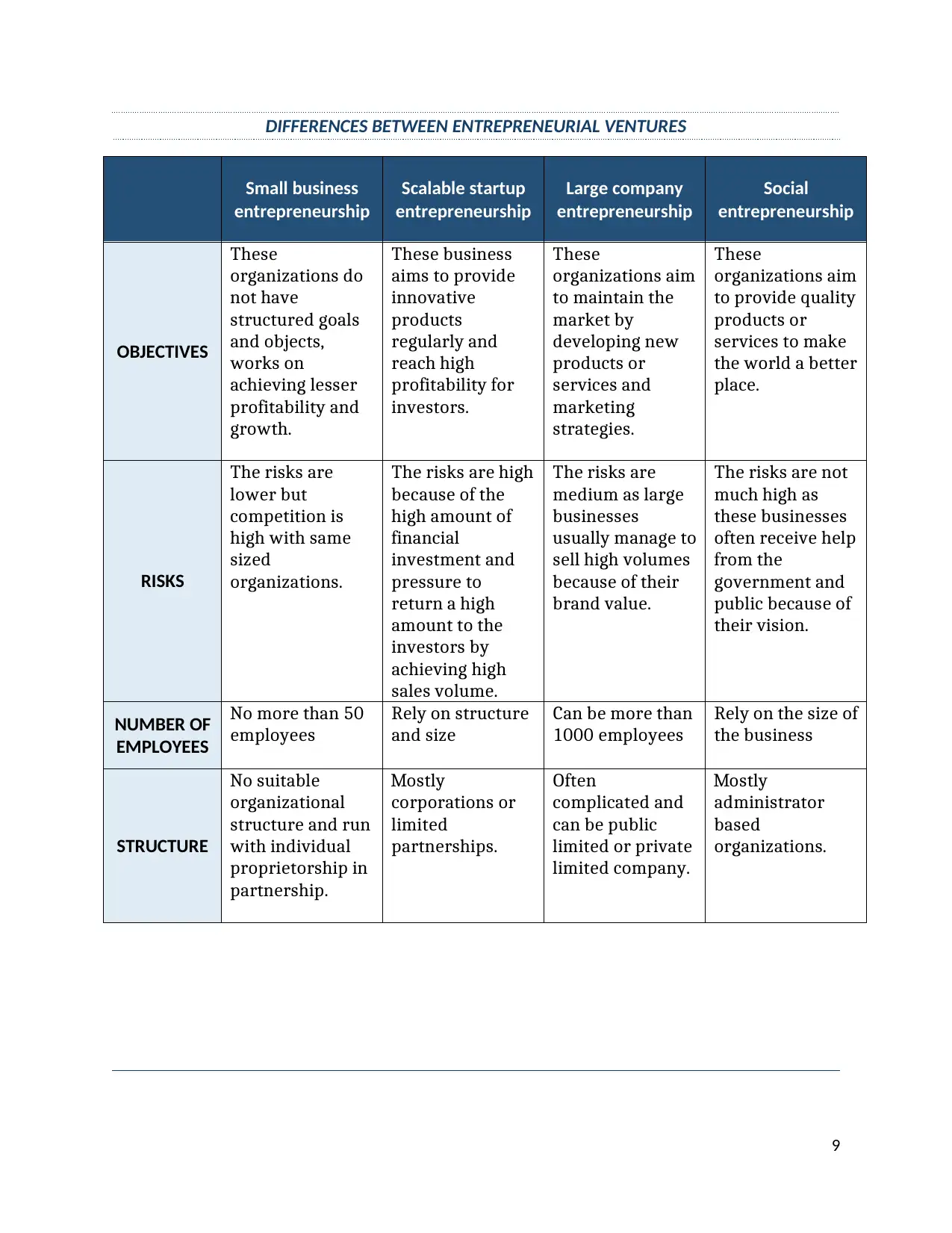
DIFFERENCES BETWEEN ENTREPRENEURIAL VENTURES
Small business
entrepreneurship
Scalable startup
entrepreneurship
Large company
entrepreneurship
Social
entrepreneurship
OBJECTIVES
These
organizations do
not have
structured goals
and objects,
works on
achieving lesser
profitability and
growth.
These business
aims to provide
innovative
products
regularly and
reach high
profitability for
investors.
These
organizations aim
to maintain the
market by
developing new
products or
services and
marketing
strategies.
These
organizations aim
to provide quality
products or
services to make
the world a better
place.
RISKS
The risks are
lower but
competition is
high with same
sized
organizations.
The risks are high
because of the
high amount of
financial
investment and
pressure to
return a high
amount to the
investors by
achieving high
sales volume.
The risks are
medium as large
businesses
usually manage to
sell high volumes
because of their
brand value.
The risks are not
much high as
these businesses
often receive help
from the
government and
public because of
their vision.
NUMBER OF
EMPLOYEES
No more than 50
employees
Rely on structure
and size
Can be more than
1000 employees
Rely on the size of
the business
STRUCTURE
No suitable
organizational
structure and run
with individual
proprietorship in
partnership.
Mostly
corporations or
limited
partnerships.
Often
complicated and
can be public
limited or private
limited company.
Mostly
administrator
based
organizations.
9
Small business
entrepreneurship
Scalable startup
entrepreneurship
Large company
entrepreneurship
Social
entrepreneurship
OBJECTIVES
These
organizations do
not have
structured goals
and objects,
works on
achieving lesser
profitability and
growth.
These business
aims to provide
innovative
products
regularly and
reach high
profitability for
investors.
These
organizations aim
to maintain the
market by
developing new
products or
services and
marketing
strategies.
These
organizations aim
to provide quality
products or
services to make
the world a better
place.
RISKS
The risks are
lower but
competition is
high with same
sized
organizations.
The risks are high
because of the
high amount of
financial
investment and
pressure to
return a high
amount to the
investors by
achieving high
sales volume.
The risks are
medium as large
businesses
usually manage to
sell high volumes
because of their
brand value.
The risks are not
much high as
these businesses
often receive help
from the
government and
public because of
their vision.
NUMBER OF
EMPLOYEES
No more than 50
employees
Rely on structure
and size
Can be more than
1000 employees
Rely on the size of
the business
STRUCTURE
No suitable
organizational
structure and run
with individual
proprietorship in
partnership.
Mostly
corporations or
limited
partnerships.
Often
complicated and
can be public
limited or private
limited company.
Mostly
administrator
based
organizations.
9
⊘ This is a preview!⊘
Do you want full access?
Subscribe today to unlock all pages.

Trusted by 1+ million students worldwide

INVESTIGATING DIVERSE RANGE OF ENTREPRENEURIAL
VENTURES TO DEMONSTRATE AN UNDERSTANDING OF
ENTREPRENEURSHIP IN BOTH PUBLIC AND CORPORATE
SECTOR
IN PUBLIC SECTOR
Public sector organizations are managed by the government directly or indirectly. The
government invests a higher amount on those organizations and different private
organizations implement strategic help to those. These types of organizations have an
establishment in different sectors and aims to provide quality products or services to the
clients. These organizations do not importance on profitability rather than social welfare
and development (Baum, 2014)
IN CORPORATE SECTOR
These types of organizations work privately and can be owned by individual or the public.
These organizations develop marketing strategies to provide quality products or services
to clients to intensify their profitability and longevity of the organizations. Many large
organizations, scalable entrepreneurship ventures are connected with corporate sectors
that concentrate on sustainable development by focusing on its competitors and
developing strategies to achieve aggressive advantages (Baum, 2014)
Comparing Corporate and Public Entrepreneurs
10
VENTURES TO DEMONSTRATE AN UNDERSTANDING OF
ENTREPRENEURSHIP IN BOTH PUBLIC AND CORPORATE
SECTOR
IN PUBLIC SECTOR
Public sector organizations are managed by the government directly or indirectly. The
government invests a higher amount on those organizations and different private
organizations implement strategic help to those. These types of organizations have an
establishment in different sectors and aims to provide quality products or services to the
clients. These organizations do not importance on profitability rather than social welfare
and development (Baum, 2014)
IN CORPORATE SECTOR
These types of organizations work privately and can be owned by individual or the public.
These organizations develop marketing strategies to provide quality products or services
to clients to intensify their profitability and longevity of the organizations. Many large
organizations, scalable entrepreneurship ventures are connected with corporate sectors
that concentrate on sustainable development by focusing on its competitors and
developing strategies to achieve aggressive advantages (Baum, 2014)
Comparing Corporate and Public Entrepreneurs
10
Paraphrase This Document
Need a fresh take? Get an instant paraphrase of this document with our AI Paraphraser

CATEGORY CORPORATE
ENTREPRENEUR PUBLIC ENTREPRENEUR
ORGANIZATIONAL TYPE Existing business Public sector organization
PERSON Corporate executive Public officer
MAIN ACTIVITY
Create value within an
innovate project
Create value for citizens by
bringing together unique
combinations of resources
SKILLS
Strong technical skills or
product knowledge; good
managerial skills; weak
political skills
Strong political skills; able to
develop power sources
beyond those formally
assigned; adept at using
public relations and the
media to advantage
FOCUS
Internal and external; builds
internal networks and finds
mentors or sponsors
Learns to co-opt or use
external forces to
accomplish internal change;
builds constituencies of
support among politicians,
unions, the private sector,
the media and the
community
RISKS AND FAILURE
Likes moderate risks;
principal risks are career
related: sensitive to need to
appear orderly within
corporation; hides risky
projects so can learn from
mistakes without political
cost of public failure
Calculated risk-taker; takes
big organizational risks
without taking big personal
risks by managing the
process by which risky
decisions are made: tends to
deviate from rules only
slightly at first, then
progressively more; since
failure is harder to define,
will manage events to
promote positive outcomes
COURAGE AND DESTINY
Self-confident, optimistic,
and bold; cynical about the
system but believes he/she
can influence/manipulate it
Self-confident, optimistic,
and bold; high tolerance for
ambiguity; uses ambiguity as
a source of managerial
discretion
(Zerbinati & Souitaris, 2005)
11
ENTREPRENEUR PUBLIC ENTREPRENEUR
ORGANIZATIONAL TYPE Existing business Public sector organization
PERSON Corporate executive Public officer
MAIN ACTIVITY
Create value within an
innovate project
Create value for citizens by
bringing together unique
combinations of resources
SKILLS
Strong technical skills or
product knowledge; good
managerial skills; weak
political skills
Strong political skills; able to
develop power sources
beyond those formally
assigned; adept at using
public relations and the
media to advantage
FOCUS
Internal and external; builds
internal networks and finds
mentors or sponsors
Learns to co-opt or use
external forces to
accomplish internal change;
builds constituencies of
support among politicians,
unions, the private sector,
the media and the
community
RISKS AND FAILURE
Likes moderate risks;
principal risks are career
related: sensitive to need to
appear orderly within
corporation; hides risky
projects so can learn from
mistakes without political
cost of public failure
Calculated risk-taker; takes
big organizational risks
without taking big personal
risks by managing the
process by which risky
decisions are made: tends to
deviate from rules only
slightly at first, then
progressively more; since
failure is harder to define,
will manage events to
promote positive outcomes
COURAGE AND DESTINY
Self-confident, optimistic,
and bold; cynical about the
system but believes he/she
can influence/manipulate it
Self-confident, optimistic,
and bold; high tolerance for
ambiguity; uses ambiguity as
a source of managerial
discretion
(Zerbinati & Souitaris, 2005)
11
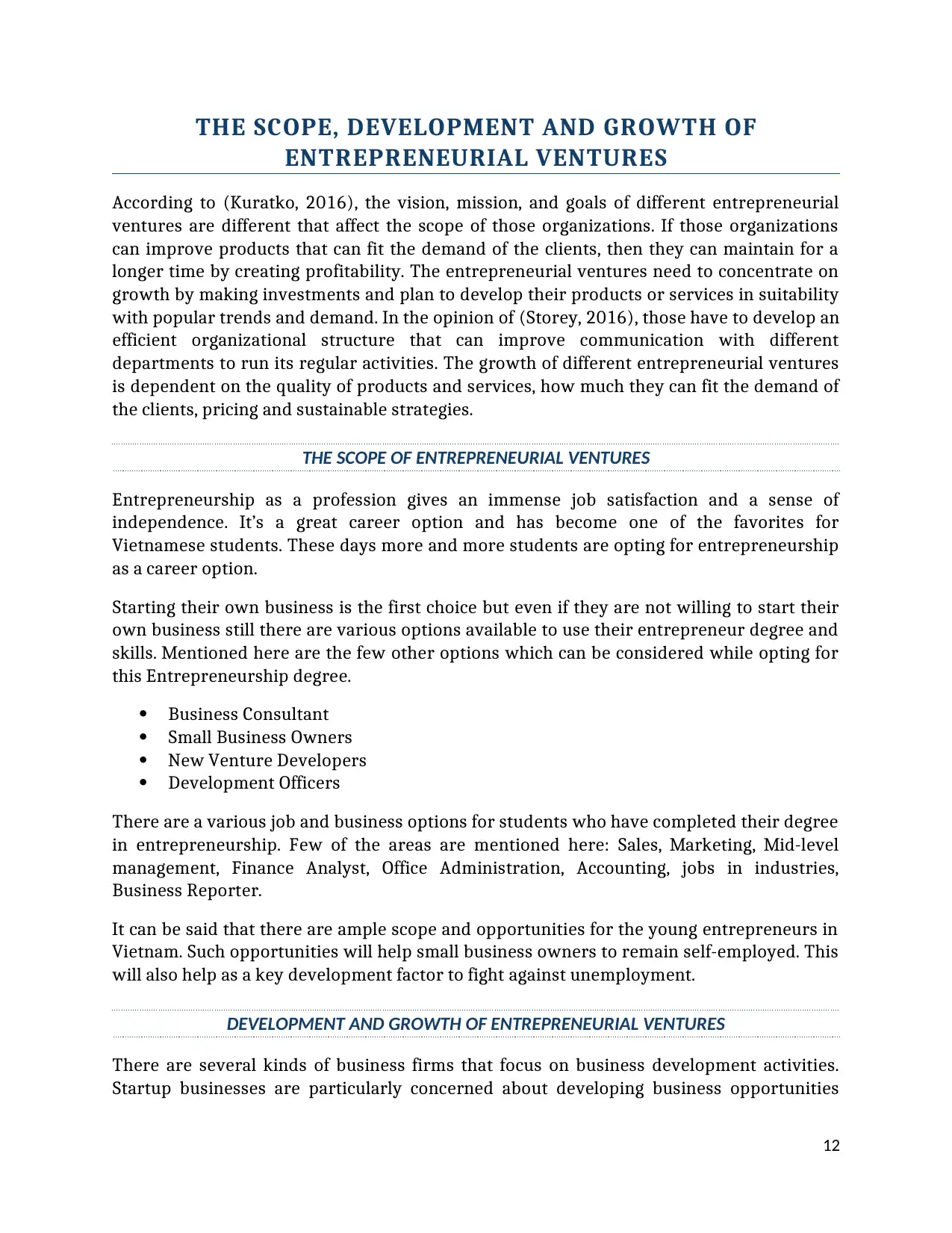
THE SCOPE, DEVELOPMENT AND GROWTH OF
ENTREPRENEURIAL VENTURES
According to (Kuratko, 2016), the vision, mission, and goals of different entrepreneurial
ventures are different that affect the scope of those organizations. If those organizations
can improve products that can fit the demand of the clients, then they can maintain for a
longer time by creating profitability. The entrepreneurial ventures need to concentrate on
growth by making investments and plan to develop their products or services in suitability
with popular trends and demand. In the opinion of (Storey, 2016), those have to develop an
efficient organizational structure that can improve communication with different
departments to run its regular activities. The growth of different entrepreneurial ventures
is dependent on the quality of products and services, how much they can fit the demand of
the clients, pricing and sustainable strategies.
THE SCOPE OF ENTREPRENEURIAL VENTURES
Entrepreneurship as a profession gives an immense job satisfaction and a sense of
independence. It’s a great career option and has become one of the favorites for
Vietnamese students. These days more and more students are opting for entrepreneurship
as a career option.
Starting their own business is the first choice but even if they are not willing to start their
own business still there are various options available to use their entrepreneur degree and
skills. Mentioned here are the few other options which can be considered while opting for
this Entrepreneurship degree.
Business Consultant
Small Business Owners
New Venture Developers
Development Officers
There are a various job and business options for students who have completed their degree
in entrepreneurship. Few of the areas are mentioned here: Sales, Marketing, Mid-level
management, Finance Analyst, Office Administration, Accounting, jobs in industries,
Business Reporter.
It can be said that there are ample scope and opportunities for the young entrepreneurs in
Vietnam. Such opportunities will help small business owners to remain self-employed. This
will also help as a key development factor to fight against unemployment.
DEVELOPMENT AND GROWTH OF ENTREPRENEURIAL VENTURES
There are several kinds of business firms that focus on business development activities.
Startup businesses are particularly concerned about developing business opportunities
12
ENTREPRENEURIAL VENTURES
According to (Kuratko, 2016), the vision, mission, and goals of different entrepreneurial
ventures are different that affect the scope of those organizations. If those organizations
can improve products that can fit the demand of the clients, then they can maintain for a
longer time by creating profitability. The entrepreneurial ventures need to concentrate on
growth by making investments and plan to develop their products or services in suitability
with popular trends and demand. In the opinion of (Storey, 2016), those have to develop an
efficient organizational structure that can improve communication with different
departments to run its regular activities. The growth of different entrepreneurial ventures
is dependent on the quality of products and services, how much they can fit the demand of
the clients, pricing and sustainable strategies.
THE SCOPE OF ENTREPRENEURIAL VENTURES
Entrepreneurship as a profession gives an immense job satisfaction and a sense of
independence. It’s a great career option and has become one of the favorites for
Vietnamese students. These days more and more students are opting for entrepreneurship
as a career option.
Starting their own business is the first choice but even if they are not willing to start their
own business still there are various options available to use their entrepreneur degree and
skills. Mentioned here are the few other options which can be considered while opting for
this Entrepreneurship degree.
Business Consultant
Small Business Owners
New Venture Developers
Development Officers
There are a various job and business options for students who have completed their degree
in entrepreneurship. Few of the areas are mentioned here: Sales, Marketing, Mid-level
management, Finance Analyst, Office Administration, Accounting, jobs in industries,
Business Reporter.
It can be said that there are ample scope and opportunities for the young entrepreneurs in
Vietnam. Such opportunities will help small business owners to remain self-employed. This
will also help as a key development factor to fight against unemployment.
DEVELOPMENT AND GROWTH OF ENTREPRENEURIAL VENTURES
There are several kinds of business firms that focus on business development activities.
Startup businesses are particularly concerned about developing business opportunities
12
⊘ This is a preview!⊘
Do you want full access?
Subscribe today to unlock all pages.

Trusted by 1+ million students worldwide
1 out of 28
Related Documents
Your All-in-One AI-Powered Toolkit for Academic Success.
+13062052269
info@desklib.com
Available 24*7 on WhatsApp / Email
![[object Object]](/_next/static/media/star-bottom.7253800d.svg)
Unlock your academic potential
Copyright © 2020–2025 A2Z Services. All Rights Reserved. Developed and managed by ZUCOL.


